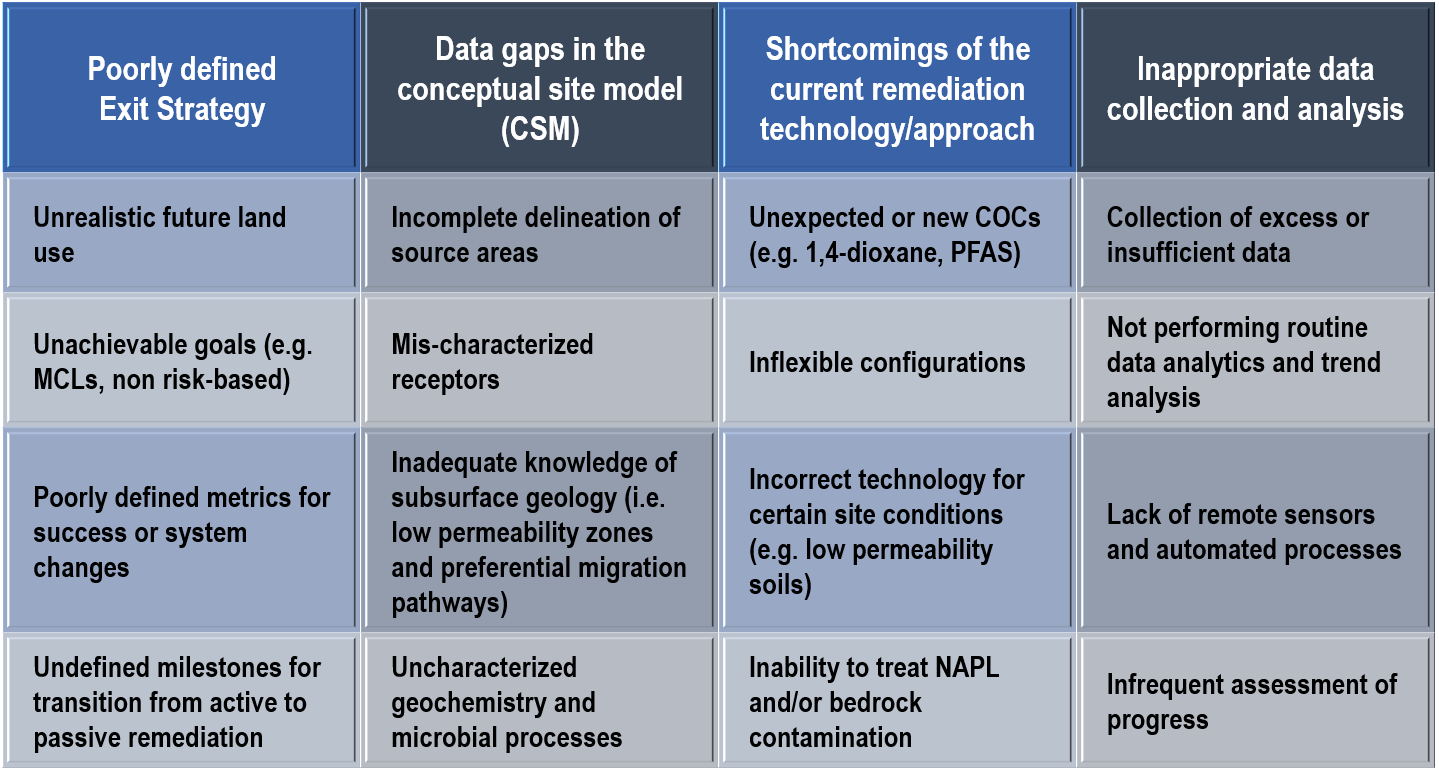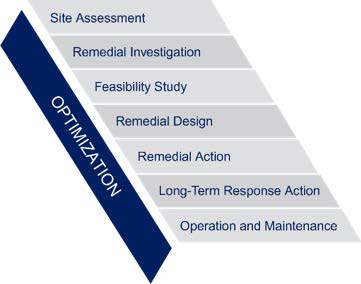A large percentage of site remediation programs implemented over the last several decades have fallen short of project expectations. Time and time again, remedies for contaminated sites do not achieve their intended objectives, resulting in either longer-term system operations or numerous attempts at remediation and incurring significant additional cost. Often, there is not a clearly established Exit Strategy to achieve site closure. Our approach for evaluating and modifying remedies to improve performance consists of the following key steps:
- Defining the remedial objectives and Exit Strategy
- Gaining an understanding of the reasons that the remedy has failed to perform to expectations
- Developing a set of potential corrective actions to modify the remedy in a positive direction (i.e., higher likelihood of success to achieve remedial objectives; lower lifecycle costs; better mitigation of human, ecological, and financial risks; more efficient and sustainable remediation; decreased time to closure)
- Prioritizing and selecting the potential modifications to the remedy based on return on investment, in terms of the ability to meet remedial objectives and lower risks, enhance financial performance, and improve remedy efficiency (e.g. contaminant mass removal over time)
- Adaptively implementing the actions by re-assessing the remediation strategy as new information on remedy performance is generated
This approach allows for a systematic refocusing of the site Exit Strategy toward a more efficient, timely, and less costly approach.
Reasons that Remedies Fail to Perform to Expectations
We have found that there are four major categories of issues commonly leading to underperformance or failure of a particular site remediation approach. These categories, along with specific examples (by no means an all-inclusive list), are presented in the following table.

Often, these issues can lead to undesirable outcomes for remediation projects, including the following:
- Inability to target constituents of concern for remediation
- Excessive and inefficient remediation efforts
- Drawn-out operations, maintenance, and monitoring activities
- Unachievable site closure
Approaches Proven to Improve Site Remedies
Remedies that are not meeting expectations can be improved and redirected towards site closure by employing a suite of strategies, as described below.
- Generating a clear, metrics-driven “road map” to define and guide the Exit Strategy
- Strengthening the CSM through the use of high-resolution site characterization techniques, molecular biological tools, geochemical evaluations, improved three-dimensional visualization of subsurface conditions, hydrogeologic testing, and focused groundwater modeling
- Employing enhanced remediation approaches such as: risk-based closures; combined remedies to treat different types of contaminants, and to harness multiple and synergistic abiotic and biological degradation processes; technologies that can facilitate access to low permeability zones; site-specific remediation chemistries designed through treatability studies; and adaptive mobile infrastructure to respond to changing system conditions
- Improving data collection and analysis processes by using metrics to streamline data collection over time, conducting routine trend analysis to adapt remedy operations, and streamlining data management and reporting efforts
Using a Peer-Review Process for Remedy Optimization
As shown in the graphic, remedy optimization can be conducted throughout the lifecycle of a remediation program.

Source: Superfund Task Force Final Report (EPA, 2019)
As part of the optimization process, peer reviews can be an effective mechanism to evaluate opportunities to improve a remedy and can be employed at any time during the remediation process. The power of the peer review process is that it consists of a systematic review and brainstorming session(s) performed to achieve better outcomes by leveraging experienced technical experts who are independent of the project team. A strong peer review process uses a prescribed format and typically consists of following generalized steps:
- Review and analysis of site summary information and performance of the remedy
- Reassessment of project objectives, the “vision” for the project, and the Exit Strategy (how to achieve the “vision”)
- Development of a clear, metrics-driven “road-map” to guide the Exit Strategy
- Analysis of how and why the remedy is not meeting expectations and identification of data gaps
- Development of a prioritized list of potential actions to fill data gaps and improve the remedy performance
- Production of an action plan that captures the results of the review and the recommended actions to optimize the remedy
- Performance of milestone reviews to track and assess the progress of implementing the recommended actions
The peer-review process can result in a more cost-effective remedy that has a better chance of achieving project goals in an accelerated time frame.
